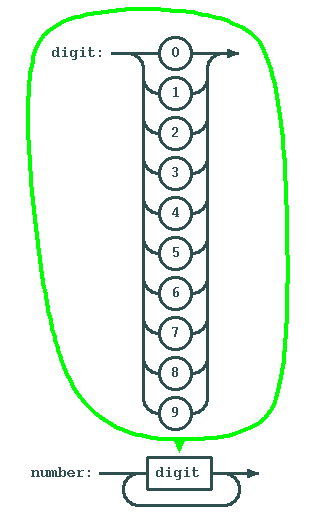
and the computer would return 70.30 + 40 return
The first step is to write a program that can recognize arithmetic expressions. This kind of program is called a parser.
Before we can write the parser, we have to analyse the structure in arithmetic expressions: the syntax. Let's look at a couple of them:
Arithmetic expressions can become quite complex. Let's start with a simple thing: Numbers.20 30 + 40 -6 6/5 + 8 5 * (4+8) 70 + (8*(4-6) * (50 + 50 + 100*44))
Even simpler than numbers are operators:
The big trick is how we combine them into expressions. One thing you notice when looking at a very complicated expression is that it seems to contain other, simpler expressions. We can express this using recursion. Recursive definitions define a concept by using simpler versions of itself. Eventually, we will stumble upon the simplest expression of them all: a number.
It seems loopy, but since every expression inside a big expression is a smaller expression, the process of parsing will eventually terminate. It will terminate once we reach the simplest possible form. This form is called a token.
Tokens are the atoms of the grammar of our language. Almost all programming languages can be decomposed in the way we did it here, i.e. a context free grammar. Sometimes, though, it is very complex. C++ in particular is very very hard to parse. You will learn more details in the compiler construction course next year.
Next Section |
Previous Section
Coding the Parser
Now, how does this look in code? The first step is to write a function
that will simply tell us if our arithmetic expression is a
well-formed one. We will write a function parse()
that will return 1 if the arithmetic expression is correct, 0 if
not.
Let's start if the simplest thing: a digit. We will use two primitives: getc() and ungetc(). The idea is simple: we read characters as long as they are what we expect. If a character suddenly is not what we expect, then we put it back so that someone else (who might want this character) can re-read it.
So, here is our function digit():
int digit()
{
int c = getc(); // getc returns an integer.
if (c >= '0' && c <= '9')
return 1;
else {
ungetc(c);
return 0;
}
}
A number consists of at least one digit. So....
int number()
{
if (digit()) {
while (digit())
;
return 1;
}
else return 0;
}
Operators are really easy - try it as an exercise...
Now expressions are slightly more complicated.
int expression()
{
// case expression begins with a number.
if (number()) {
if (operator())
return expression();
else
return 1;
// case expression begins with something else:
int c = getc();
if (c == '-') return expression();
if (c == '(') {
if (!expression()) return 0;
c == getc();
return (c == ')');
}
return 0;
}
If you click on the diagrams above, you will obtain a symbolic
notation that has the same meaning as the diagrams. Note how closely
the symbolic notation resembles the code. In fact, this resemblance is
so close that one can automatically translate from the symbolic
notation (also called the grammar rules) into C. Under UNIX,
there are programs like lex, yacc and bison that do
this.
Next Section |
Previous Section
Parse Trees
Now if we actually wanted to represent an expression internally as an
object, we have to work a little harder.
One data structure that is inherently recursive is the tree. It is therefore ideally suited to represent expressions. In fact, trees are so versatile that it is standard procedure to represent anything governed by a context free grammar by a so called parse tree.
This is how the parse tree of an expression would look like:
The exact details on how to make those trees and how to evaluate them must be left for later, otherwise the compiler construction teacher will be out of his job...
Of interest for us here is that the technique of reading and writing objects in general can become quite complex, and that the basic aim of the monopoly project is to show you how to start doing it. Later, you will be able to consider a whole program as just another object.
Previous Section |
Contents
Application to our Monopoly Engine
The most important idea to carry over from the above is the
backtracking idea. In the code above, we used
ungetc() to push back unwanted characters.
In today's exercise, you will install a new base class with full scale parsing. The Base::read() function will be able to backtrack whenever it finds an object it didn't expect.
Today's other exercise will be to implement the list object. We are now prepared to understand how we will parse a list object, and how we will implement it:
Now we can see how convenient it is to use virtual functions for the contents, and a fixed set of functions for the form. We can concentrate all the ugly code into one module, and emphasize the actual data inside the objects.